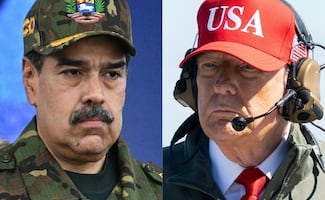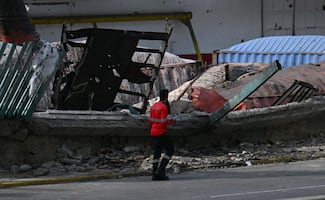Más Información

Captura de Maduro: Así es el USS Iwo Jima (LHD-7), el buque de asalto anfibio que traslada al líder venezolano a EU

EU captura a Nicolás Maduro: Así fue “Absolute Resolve”, la operación para detener al líder venezolano

Países de AL han buscado a México tras ataque de EU a Venezuela, dice Sheinbaum; hace un llamado a la unidad
A clash high in the Himalayas between the world’s two most populated countries claimed the lives of 20 Indian soldiers in a border region that the two nuclear armed neighbors have disputed for decades, Indian officials said Tuesday.
Recommended: India and China defuse military tensions in the “Roof of the World”
The clash in the Ladakh region Monday—during which Indian officials said neither side fired any shots—was the first deadly confrontation between India and China since 1975. Experts said it would be difficult for the two nations to ease heightened tensions.
The Indian and Chinese troops fought each other with fists and rocks, Indian officials said on condition of anonymity because they were not authorized to disclose the information.
The Indian Army initially said in a statement that three Indian soldiers had died, but later updated the number to 20 and said 17 “were critically injured in the line of duty at the standoff location and exposed to sub-zero temperatures in the high altitude terrain.” The statement did not disclose the nature of the soldiers’ injuries.
China
accused Indian forces of carrying out “ provocative attacks ” on its troops without offering more details and did not disclose if any of its soldiers died.
After the clash, the two sides “disengaged” from the area where the the fighting happened, the Indian Army statement said.
The United Nations urged both sides “to exercise maximum restraint.”
“We are concerned about reports of violence and deaths at the Line of Actual Control between India and China ,” U.N. associate spokesperson Eri Kaneko said. “We take positive note of reports that the two countries have engaged to de escalate the situation.”
China
claims about 90,000 square kilometers (35,000 square miles) of territory in India’s northeast , while India says China occupies 38,000 square kilometers (15,000 square miles) of its territory in the Aksai Chin Plateau in the Himalayas , a contiguous part of the Ladakh region .
India
unilaterally declared Ladakh a federal territory while separating it from disputed Kashmir in August 2019. China was among the handful of countries to strongly condemn the move, raising it at international forums including the U.N. Security Council .
Thousands of soldiers on both sides have faced off over a month along a remote stretch of the 3,380-kilometer (2,100-mile) Line of Actual Control , the border established following a war between India and China in 1962 that resulted in an uneasy truce.
Chinese Foreign Ministry spokesman Zhao Lijian
gave no details of any casualties on the Chinese side, but said that China had strongly protested the incident and remained committed to maintaining “peace and tranquility” along the disputed and heavily militarized border.
“But what is shocking is that on June 15, the Indian troops seriously violated the consensus of the two sides, crossed the border illegally twice and carried out provocative attacks on Chinese personnel , resulting in serious physical conflicts between the two border forces,” Zhao said.
India’s Ministry of External Affairs
said in a statement that the incident happened “as a result of an attempt by the Chinese side to unilaterally change the status quo” in the Galwan Valley .
Thousands of soldiers from the two countries, backed by armored trucks and artillery, have been stationed just a few hundred meters (yards) apart for more than a month in the Ladakh region that lies near Tibet . Army officers and diplomats have held a series of meetings to try to end the impasse, with no breakthrough.
Indian authorities have officially maintained near-total silence on the issues related to the confrontation
But two Indian security officials familiar with latest developments disclosed that soldiers from the two sides had engaged in the fistfights and stone-throwing , which led to the casualties. Both said that no shots were fired by either side, speaking on condition of anonymity in keeping with government regulations.
Indian Prime Minister Narendra Modi
did not comment on the clash in a televised meeting Tuesday with state officials.
The tense standoff started in early May, when Indian officials said that Chinese soldiers crossed the boundary in Ladakh at three different points, erecting tents and guard posts and ignoring verbal warnings to leave. That triggered shouting matches , stone-throwing and fistfights , much of it replayed on television news channels and social media.
China
has sought to downplay the confrontation while saying the two sides were communicating through both their front-line military units and their respective embassies to resolve issues.
Though skirmishes aren’t new along the frontier, the standoff at Ladakh’s Galwan Valley , where India is building a strategic road connecting the region to an airstrip close to China , has escalated in recent weeks.
The two countries have been trying to settle their border dispute since the early 1990s without success.
The last time there were fatalities along the disputed border was in 1975 , when Chinese troops killed four Indian soldiers in an ambush in the Twang region of northeastern India’s Arunachal Pradesh state , said Lt. Gen. D.S. Hooda , a former head of the Indian military’s Northern Command .
“It’s a very complicated and serious situation, and it will take real, hard negotiating skills to resolve this,” Hooda said.
Indian officials
have said Chinese soldiers commit more than 500 border transgressions annually.
sg
Noticias según tus intereses
[Publicidad]
[Publicidad]











